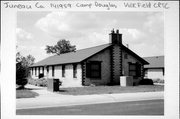Property Record
VOLK FIELD CRTC
Architecture and History Inventory
| Historic Name: | Building 129 |
|---|---|
| Other Name: | Building 129 |
| Contributing: | |
| Reference Number: | 141959 |
| Location (Address): | VOLK FIELD CRTC |
|---|---|
| County: | Juneau |
| City: | Camp Douglas |
| Township/Village: | |
| Unincorporated Community: | |
| Town: | 17 |
| Range: | 2 |
| Direction: | E |
| Section: | 21 |
| Quarter Section: | |
| Quarter/Quarter Section: |
| Year Built: | 1941 |
|---|---|
| Additions: | |
| Survey Date: | 2006 |
| Historic Use: | dining hall |
| Architectural Style: | Front Gabled |
| Structural System: | Masonry |
| Wall Material: | Tile |
| Architect: | Hengels, Henry C. |
| Other Buildings On Site: | |
| Demolished?: | No |
| Demolished Date: |
| National/State Register Listing Name: | Not listed |
|---|---|
| National Register Listing Date: | |
| State Register Listing Date: |
| Additional Information: | This enlisted men's mess hall was one of 15 mess halls built for the 127th Infantry Regiment and was reported as nearing completion in the June 1941 issue of the Wisconsin National Guard Review. The mess hall was designed by Lt. Colonel Henry C. Hengels, State of Wisconsin Military Architect and Engineer. The mess hall had two interior spaces: a kitchen and a dining area. The building could accommodate 100 persons and was oriented so that the dining area faced the troop encampment. Troops accessed the building through double doors that occupied the front gable end. The kitchen at the rear of the building had a separate single door. The 1941 mess hall design featured an exterior chimney centered on the gable end. The building measures 25 x 75 feet and rests on a stuccoed concrete wall foundation with a metal watertable. The exterior walls are constructed of tan clay tile with red brick corner quoins. The gable roof is sheathed with composition shingles with plain exposed purlin ends, plain rafter ends, and wood eave boards. Each upper gable end wall is finished with a band of red brick. The upper gable end of the west elevation has a rectangular wood louvered vent with canted corners. The windows are metal-frame, one-over-one-light, double-hung sash units that replaced the original wood-frame, six-over-six-light, double-hung sash. The windows have wood lintels and concrete sills. The original doorway located in the west elevation contains paired wood-paneled doors with an ornamental wood sill that is a later installation; the west entry is no longer used. The doorway has a brick surround and wood lintel. A secondary metal door is located along the side elevation. The original door opening has a brick surround. A few original vertical wood board window shutters have been retained. After the property was leased for use by the Air National Guard in 1954, this building was converted into open bay barracks. In 1965, the interior of the building was reconfigured to contain individual rooms, and heating and a shared shower and bathroom plumbing were installed to accommodate year-round occupancy by personnel of the 343rd Fighter Group, Air Defense Command of the U.S. Air Force who were stationed at the installation between 1965 and 1972. As part of the 1965 renovation, some window and door openings were reconfigured and a new doorway was installed on the side elevation. During the late 1980s, the building was reconfigured to contain a day room and updated heating and plumbing systems were installed. The doors on the west end were closed off. |
|---|---|
| Bibliographic References: | Volk Field CRTC, real property records, drawings files. Wisconsin National Guard Review, June 1941. Wisconsin Veterans Museum Archives, Madison, blueprint drawings, Camp Williams. Wisconsin National Guard Museum, Volk Field CRTC, 1955 Conditions Survey. |
| Wisconsin Architecture and History Inventory, State Historic Preservation Office, Wisconsin Historical Society, Madison, Wisconsin |

